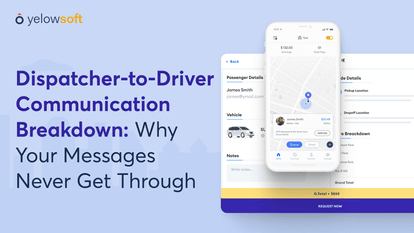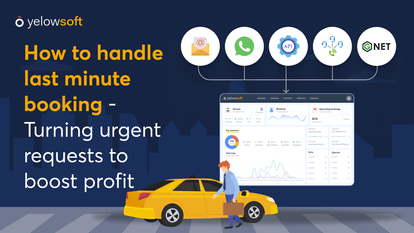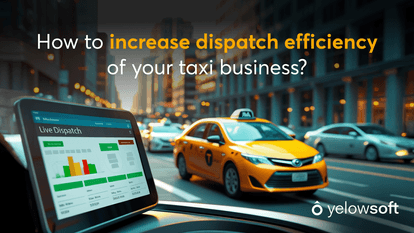Private hire operators and taxi firms face tighter service expectations and closer financial scrutiny. This article places your decisions inside today’s Taxi dispatch trends and focuses on practical steps that improve daily operations.
We use an operator’s lens. You will see how results driven Taxi automation converts dispatcher judgment into consistent outcomes by acting on clear signals, applying sensible rules, and preserving human oversight where it matters most.
Here is what you can expect. First, a plain explanation of the automation loop from booking to payout. Next, where AI helps and where it does not. Then a short use case with numbers you can reproduce. After that, uncommon features that reduce effort and protect margin. We close with a checklist you can run this week.
Business travel is also firming up the case for reliability and clean reporting. Deloitte’s 2024 Corporate Travel Study notes that managers expected growth in 2024 and see momentum continuing at roughly two to three times GDP, which keeps pressure on punctuality, invoicing accuracy, and service visibility. *Deloitte
Now let us move from context to definitions and see how automation actually works.
What taxi automation is, how it works, and why operators adopt it
Automation turns live signals into consistent actions that reduce effort and raise reliability for mixed fleets and airport work during peaks and quiet nights alike across cities and suburbs.
Signals, rules, and events that drive automated decisions
Key signals include ETA, distance to pickup, vehicle class, compliance status, shift status, and flight ETA.
Rules convert inputs into offers for eligible drivers, with timeouts that return jobs to the queue and alerts for dispatcher review.
Operators adopt Taxi automation to lift early acceptance and steady service outside city cores and during off hour windows.
From booking to payout. The measurable loop
A job is created and allocated, communications confirm details, the ride completes, settlements post, and reports close the loop.
Feedback such as accept reasons, cancel reasons, wait times, and exceptions improves the next cycle.
Taxi automation inside Automated taxi dispatch software makes steps visible and repeatable, while clean settlements reduce month end disputes.
Next, we show where AI adds precision and where oversight remains.
AI in dispatch. Where it helps and where it does not
Think of AI as a sharp assistant. It is fast, but it needs clear rules and clean data from you.
Demand prediction, eligibility scoring, and routing choices
Use short horizon demand prediction to stage cars before the rush. Score driver eligibility with signals like proximity, car class, compliance, shift status, and recent acceptance behavior.
Let routing respect traffic, your service goals, and airport rules. Keep the scope tight inside Automated taxi dispatch software so models do a few things very well.
If you struggle after hours, a voice agent can answer calls, capture the booking, and drop it in the queue with the right tags.
Human oversight and clear override paths
You still make the final call. Keep review gates for VIPs and tricky cases. Escalate late flights or special vehicle notes.
Record every step so your team can see who acted and why. Let Taxi automation handle the routine, and step in only when the system asks for help.
Now let us run one small pilot and measure real gains.
Use case. Faster allocation and higher acceptance with broadcasting and compliance
This section gives you a small, controlled pilot you can run without changing your whole operation.
The aim is simple. Prove that tighter eligibility plus clear timeouts move jobs to the right drivers faster, improve punctuality, and cut dispatcher workload, all with numbers you can verify.
Method and setup
Here is a simple pilot you can run. Take two comparable weeks as your baseline, then two weeks with one change: broadcast new jobs only to eligible drivers filtered by class, distance, document status, and shift status.
Set a fair timeout that pulls the job back to the console for a dispatcher decision. Track four numbers: allocation time, acceptance within two minutes, on time rate, and dispatcher minutes per 100 trips.
Run this inside Automated taxi dispatch software so every offer, timeout, and handoff is recorded.
For airport context, US carriers posted a 78.10 percent on time arrival rate in 2024, which shows why flight aware adjustments matter. *Department of Transportation
Before and after results (described in prose)
Expect conservative gains if the filters are tight. Allocation time usually falls because first offers go to drivers most likely to accept.
Early acceptance rises for the same reason. On time rates improve when the timeout quickly returns edge cases to the console.
Dispatcher minutes per 100 trips drop because fewer jobs need manual juggling. Repeat the pilot on city routes and airport corridors at different dayparts to confirm the pattern.
The key is transparency. Automated taxi dispatch software lets you explain every result with logged steps.
If you want, we can set up this exact pilot on your routes, tune the filters, and review the results together after two weeks.
With proof on the board, let us look at everyday features that quietly save time and protect margin.
Uncommon features that matter to PHOs
These are the quiet upgrades that lower workload and protect margins. Flight aware rescheduling, tiered allocation, and corporate controls turn busy days into steady ones for your team and your riders.
Flight tracking with proactive rescheduling
When ETA or gate changes, the system shifts pickup windows and alerts rider, driver, and dispatcher.
Delays are common, with US on time arrivals near 78 percent in 2024. Source. This is a practical Taxi dispatch innovation you can feel at the curb.
Tiered allocation that protects the house fleet
Your cars first, trusted partners second, wider network last. This order keeps service level promises for key accounts and protects margin when demand spikes.
Corporate account controls and monthly statements
Give roles to requesters, approvers, and finance. Set budgets and cost centres. Export clean statements that match how auditors review invoices. Finance trusts what it can verify.
With features in place, let us look at modern operating models that turn them into daily advantages.
Innovation in how PHOs run the business today
Today’s edge comes from simple, owned funnels and steady account habits. Start by controlling the path to every booking, then make your sales motion repeatable.
These moves reflect the Taxi dispatch trends you can act on right now.
Own demand with clean web booking and a balanced channel mix
Publish a three step booking flow on your website with clear prices and card on file. Keep the path short.
Offer WhatsApp for quick reorders so regulars do not call the desk for simple changes. Use aggregators where they bring high intent airport or hotel jobs, then measure their true margin.
The point is control. You own the data, the payment, and the relationship.
A repeatable corporate sales motion and service reporting
Run one motion every time. Start with discovery that maps routes, spend, and pain.
Show a tailored demo that mirrors their approvals. Offer a short pilot with one team and a single success metric.
Roll out with training and a one page monthly report on punctuality, acceptance, completion, and refunds.
Budgets are tighter in 2025 and many firms are cautious about increases, which makes clear results essential. Deloitte 2025 Corporate Travel Outlook.
To close, here is a short plan you can run this week.
Operator checklist and next steps
Here is a short plan you can run this week. Each step is small, practical, and easy to verify.
Tackle them in order, measure the results, and keep what works. The aim is steady improvements you can see in allocation time, on time arrivals, and month-end accuracy.
Five actions to implement this week
-
Publish a three step booking page on your website with clear prices and card on file. Keep the path short and test it on mobile.
-
Define pricing rules for zones, clients, and time windows. Run edge case tests for airport surcharges, wait time, and cancellations before you go live.
-
Enable broadcasting with compliance filters so only eligible drivers see new jobs. Set a fair timeout that returns unaccepted jobs to dispatch for review.
-
Turn on preauthorisation for retail cards and use clean settlements that separate company share and driver share. This reduces month end disputes and speeds reconciliation.
-
Adopt a one page monthly service report that shows punctuality, acceptance, completion, and refunds with one action you will take next month.
If you want a guided run through of these steps inside your operation, book a tailored demo with the Best taxi dispatch software for PHOs.
For context on rider expectations at scale, see Uber’s published trip volumes which signal how normal live tracking and quick allocation have become. Uber Investor Relations
Conclusion
Modern dispatch rewards clear systems and steady habits. When you read the right signals, apply firm rules, and reserve human judgment for exceptions, the floor gets calmer and faster.
The pilot you ran proves whether broadcasting with compliance filters fits your routes.
Flight aware rescheduling, tiered allocation, and corporate controls remove daily friction and reduce month end noise.
The checklist turns these ideas into quick wins you can verify in days. Start with one corridor, track results, and scale what works.
That is how operators protect margin, keep clients loyal, and build a service team members are proud to run.
Apply these innovations and lead the taxi dispatch industry with Yelowsoft
- Deloitte - Corporate Business Travel Survey
- Department of Transportation - Air Travel Consumer Report: December 2024, Full Year 2024 Numbers
FAQs
Taxi automation reads signals like ETA, distance, car class, compliance, and shift status, then applies rules to offer jobs, set timeouts, and notify staff. This delivers faster allocation, steadier on time arrivals, and less dispatcher workload.
Start with ride broadcasting plus compliance filters. This taxi dispatch innovation targets early acceptance and reduces manual juggling. Measure allocation time, acceptance within two minutes, on time rate, and dispatcher minutes per one hundred trips.
Automated taxi dispatch software monitors flight ETA and gate changes, adjusts pickup windows, and alerts rider, driver, and dispatcher. It cuts idle time and missed connections while keeping reports and settlements clean for finance and account teams.
Focus on reliability, airport aware workflows, and corporate controls. Taxi dispatch trends show value in clean web booking, tiered allocation that protects your fleet, and one page service reports that make renewals easier for procurement and finance.
Define routes, service levels, and finance needs first. The best taxi dispatch software for PHOs should support pricing rules, flight tracking, tiered allocation, corporate statements, and clear audit logs, with pilots that prove results on your corridors.




